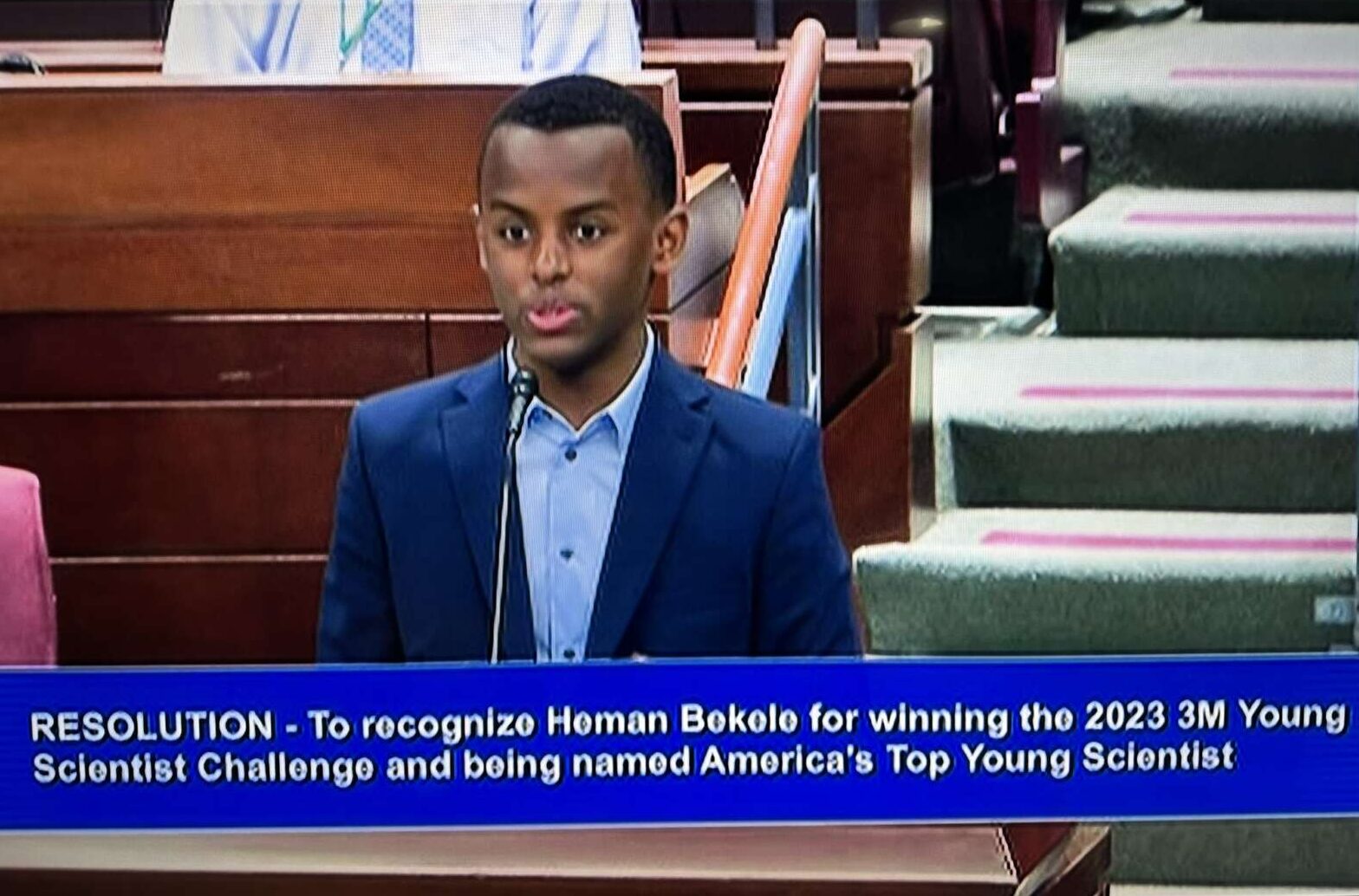
A local teen who was recently named the “Top Young Scientist in America” got a round of applause this morning (Tuesday) from the Fairfax County Board of Supervisors.
Heman Bekele, a ninth-grader at Woodson High School, won the annual 3M Young Scientist Challenge in October for developing a soap that could potentially be used to treat skin cancer. He beat out nine other finalists for the 2023 contest’s grand prize, which came with $25,000 and the aforementioned title.
The Board of Supervisors recognized Heman’s accomplishment with a unanimously approved resolution at its meeting today.
“This is a legitimate breakthrough that Heman discovered and produced,” said Braddock District Supervisor James Walkinshaw. “Especially for those of us whose science experiments ended with our ability to glue a picture of a tree on a board, to see and read about what you have done here is really amazing.”
According to the resolution read by Chairman Jeff McKay, Heman was inspired to create his Skin Cancer Treating Soap (SCTS) by his background as an immigrant from Ethiopia, where cancer is a significant but underreported cause of death. Though he was only 4 when his family moved to the U.S., Heman has said that he remembers seeing people work long hours under the hot sun.
Now 14 years old, Heman wanted to come up with a more affordable treatment option, as costs for existing treatments for the most common cancer in the U.S. have climbed.
According to a Fairfax County Public Schools profile, Heman created the soap by experimenting with different chemical compounds like alicylic acid, glycolic acid and tretinoin that can reactivate dendritic cells, which are part of the body’s immune system.
The final product could be manufactured for just 50 cents a bar. The county board’s resolution lauded Heman for his “enthusiasm and dedication, including long hours of researching and testing in his family’s kitchen and basement.”
For the 16th annual 3M Young Scientist Challenge, Heman was paired with one of the company’s scientists and spent four months turning his concept into a prototype. He was named the competition’s winner at 3M’s global headquarters in St. Paul, Minnesota, on Oct. 9 and 10.
After the board approved its resolution, Heman thanked his parents — including his mother, who works as a special education teacher at Lynbrook Elementary School in Springfield — as well as the teachers who have supported him since he began attending FCPS as a kindergarten student.
“What I’m hoping to do is turn this passion project into more than that,” Heman told the board. “I’m hoping to turn it into more of a nonprofit organization where I can provide equitable and accessible skin cancer treatment to as many people as possible, so that’s the end goal, just to help people, see a real change and a positive impact on the world.”
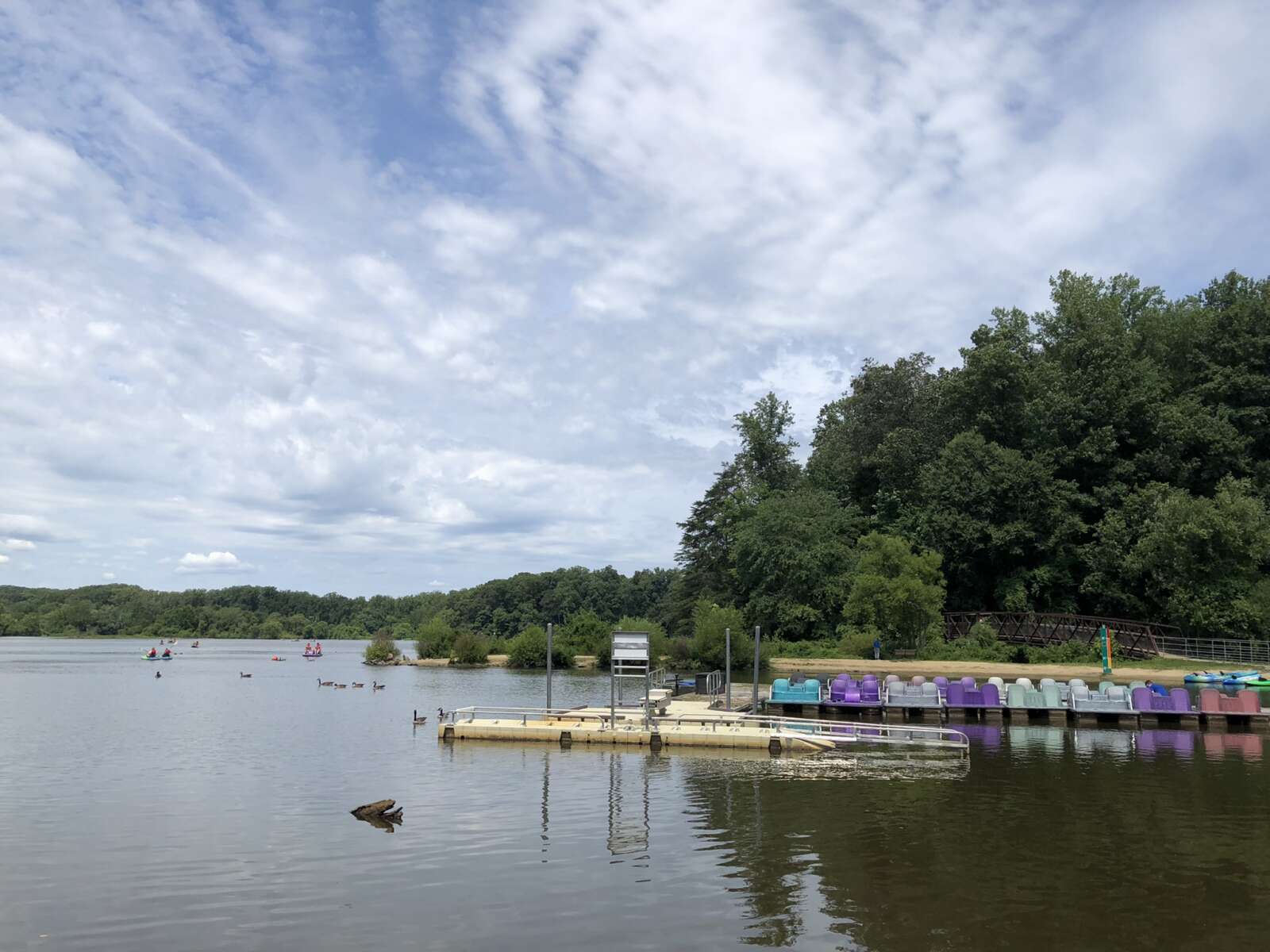
The Fairfax County Board of Supervisors hopes to preserve a smaller version of Lake Accotink, but a number of questions still need to be answered before it commits to a specific action plan.
At Braddock District Supervisor James Walkinshaw’s request, the board directed staff yesterday (Tuesday) to begin a series of studies to flesh out a task force’s determination that it would be feasible for the county to save 20 to 40 acres of the Springfield lake as opposed to fully dredging it or allowing it to disappear.
“This has been closely coordinated with staff, so they’re aware of all of this,” Walkinshaw said prior to the unanimous board vote. “I believe we should proceed with the smaller lake option unless the feasibility study identifies unforeseen hurdles.”
In addition to a feasibility study that will look at the process, costs, implementation timeline and other factors of the potential project, the county will conduct a sedimentation rate study to get updated calculations of how much sediment is flowing into and out of Lake Accotink. A separate analysis will assess whether the man-made dam that created the lake meets Virginia’s current regulatory standards and the cost of any needed improvements.
To support the studies, the board told staff to develop a community engagement plan and assign a Department of Public Works and Environmental Services employee to coordinate the work, either by creating a new position or repurposing an existing one.
The county has already committed $60.5 million to Lake Accotink in its capital improvement program (CIP), according to Walkinshaw’s board matter. Approved in 2019 and 2021 to help dredge and maintain the lake, the funds will be continued in the next CIP, which is slated to be unveiled on Feb. 20 with the proposed fiscal year 2025 budget.
“I think we’re in a much better spot now than we were just a few weeks ago,” Hunter Mill District Supervisor Walter Alcorn said. “I am very interested in the feasibility study not just looking at the initial costs of preserving Lake Accotink as a smaller lake, but also the ongoing maintenance costs and future capital costs.”
Lake Accotink Park (7500 Accotink Park Road) is one of the Fairfax County Park Authority’s most popular facilities, in part because of the boat rentals offered by its marina. However, the once-110-acre lake has shrunk to 49 acres due to sentiment transported by Accotink Creek, according to the Lake Accotink Task Force report released in December.
After previously planning to dredge the lake, a process undertaken in 1985 and 2008, county staff recommended last February that the lake instead be turned into a wetland, stating that the projected cost and neighborhood and environmental impacts no longer made dredging viable.
As community members urged the county to save Lake Accotink, the Board of Supervisors convened a task force led by former board chair Sharon Bulova to study if a smaller lake could be feasibly maintained with an initial, partial dredge, followed by regular maintenance dredges.
The task force studied the possibility of a 22-acre, 33-acre or 41-acre lake and found all of them could work, preserving the lake for recreation “while minimizing maintenance costs and impacts on surrounding communities,” Walkinshaw said in his board matter.
The smaller lake could be supplemented by trails, a managed wetland and other new amenities, the task force suggested. After the new feasibility study is completed, the park authority will restart a master planning process that was put on hold when the COVID-19 pandemic hit.
Depending on the exact size of the lake, the task force estimated that it could cost $24 to $34 million for an initial dredge that would restore a depth of 4-8 feet, but future maintenance costs are expected to be far lower than the $395 million that the county says it would take to preserve the full lake for the next 25 years, Walkinshaw noted.
Lingering questions include how to transport and dispose of the dredged sediment. A task force member suggested the Robinson Terminal Warehouse (7201 Wimsatt Road) as a processing site, but the property owners have made it “pretty clear they weren’t interested” when approached by county staff, according to Walkinshaw.
“Obviously, as this moves forward, all the potential processing sites will have to be reevaluated. For the time being, that’s been affirmed no,” he said.
Board Chairman Jeff McKay called the vote to initiate the feasibility study “a big step” in a discussion that’s been ongoing since 2016.
“Making sure the community knows where we’re heading is really critical here,” McKay said. “We still have some t’s to cross and i’s to dot here. This is a milestone moment, but not the end by any stretch of the imagination, and I know this will continue to be an issue of countywide importance until it’s resolved.”
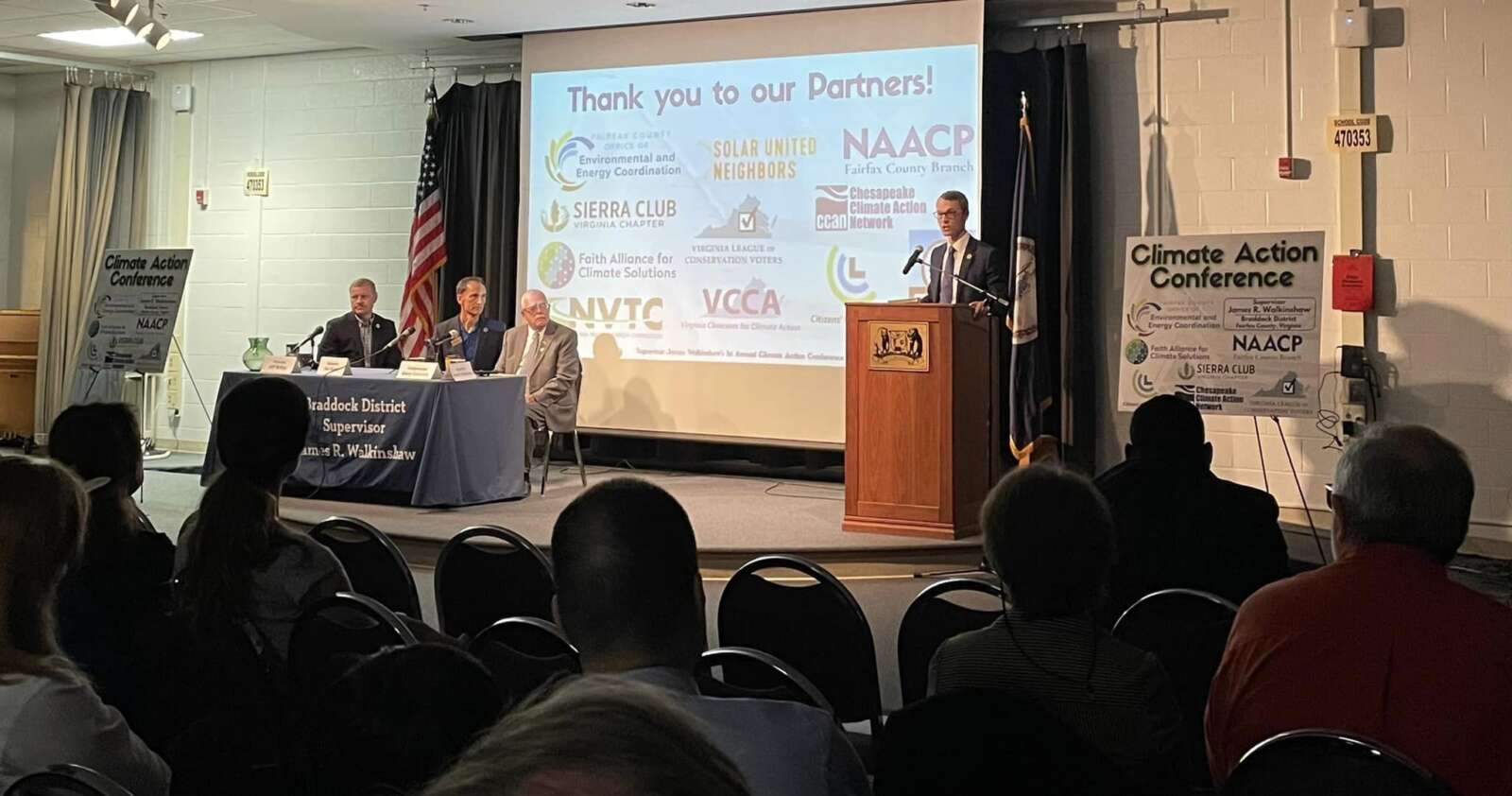
Fairfax County residents are underutilizing publicly-funded incentives to make their homes more green. That’s according to James Walkinshaw, Fairfax County Supervisor for the Braddock District, who hosted the county’s first Climate Action Conference on Sept. 30.
Greeting a crowd of community members gathered at Lake Braddock Secondary School, Walkinshaw said the focus of the conference was to give residents “all the actionable information and the tools you need to reduce your emissions and save money.”
“Whether you’re an individual, a family, a homeowner, a business leader, or a leader of a faith community or faith group, now is the time to take advantage of those opportunities,” Walkinshaw said.
Walkinshaw was joined by U.S. Rep. Gerry Connolly, Fairfax County Board of Supervisors Chair Jeff McKay and Mount Vernon District Supervisor Dan Storck.
The board members touted their record on the environment, including the hiring of 16 employees to address climate policies and piloting electric buses on both Fairfax Connector and Fairfax County Public Schools bus routes.
Sherie Cabalu, a homeowner in Vienna, came to the Climate Conference to learn about what she could do personally to combat climate change.
“I really wanted to just find out what we could do at a home level and a personal level,” Cabalu said. “You know, we hear about all the policies and everything, but how does that translate into actual, you know, doing something at the individual level?”
The event’s keynote speaker was Michael Forrester, assistant director of partnerships in the Office of State and Community Energy Programs at the Department of Energy. The mission of Forrester’s office is to share information at the community level about federal incentive programs that people can partake in to reduce their carbon footprint and save energy costs.
“We’re trying to activate local communities, and we’re trying to put these technologies in people’s homes to make a big significant difference on the nation’s carbon footprint,” Forrester said, adding, “Significant amounts of money are flowing from the federal government to local communities and to individuals’ homes.”
Low-income households can apply for the Weatherization Assistance Program, which offers home energy audits and makes necessary improvements and repairs to heating and cooling systems. The improvements are free of charge and may include work on windows and doors, roof repairs and HVAC sealing, thereby improving efficiency and lowering lower energy bills, according to Forrester.
Clean Vehicle Tax Credits are also available for Virginians to get back up to $7,500 for the purchase of a new electric vehicle, or up to $4,000 for a used electric vehicle. Restrictions apply based on the buyer’s annual income and the value of the vehicle.
Forrester also said homeowners are eligible to receive a tax credit equal to 30 percent of the cost of energy-efficient home improvements like solar panels and geothermal heat pumps. This long-term credit is part of the Inflation Reduction Act of 2022 and will be in effect for 10 years.
More incentives are coming soon to Virginians. Starting next year, Forrester said homeowners will be eligible for additional support. Under the Inflation Reduction Act’s Home Energy Rebate programs, homeowners will be able to receive up to $3,200 in additional tax credit for investment in more efficient heating systems, windows and doors. Read More
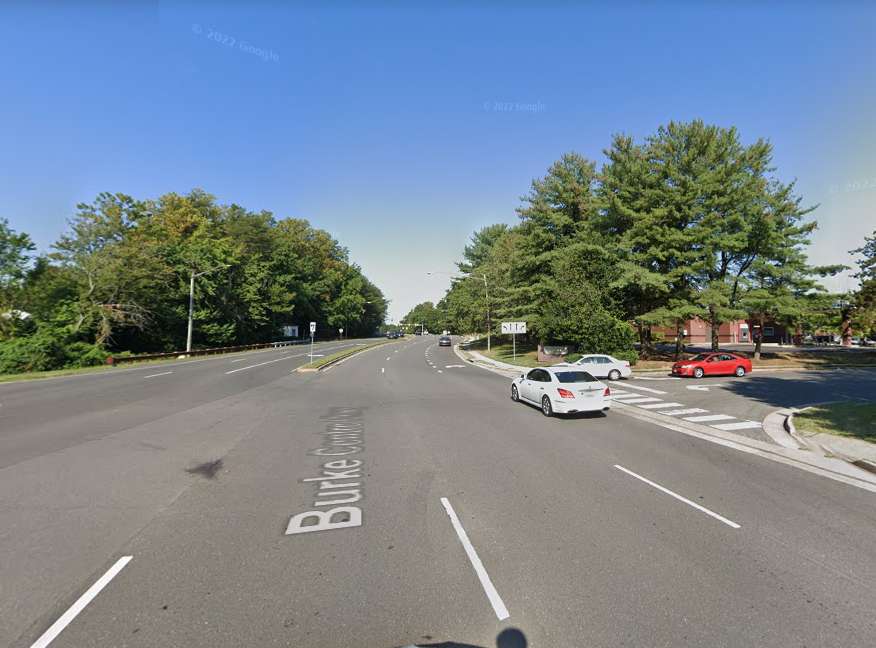
In October, the Virginia Department of Transportation will put together recommended improvements for the portion of Burke Centre Parkway where a fatal crash occurred last month.
The recommendations will come after VDOT staff can review the official police investigative report on the crash in September. The department is also planning to conduct studies on potential speed limit changes and the feasibility of a traffic signal in September and October.
The exact dates when the recommended improvements will be presented and implemented are to be determined, VDOT Assistant District Administrator Steven Welch said at a virtual community meeting about the parkway Tuesday night (August 15).
The timeline for implementation can depend on the nature of the changes. A median closure would take less time put in place than a new traffic signal, for example, Welch said.
“The range is really wide,” he said.
Welch also recapped safety improvements made on Burke Centre Parkway in the last three years, which include removing the flashing yellow arrow from 3:30 to 5:30 p.m. at the intersection of Burke Centre Parkway and Roberts Parkway and adding pedestrian warning signs at four crosswalks.
More than 70 people attended the virtual community meeting, which Braddock District Supervisor James Walkinshaw hosted in the wake of the July 18 crash that killed 17-year-old Rebekah Zarco and hospitalized three other teens.
The bulk of the roughly hour-long meeting featured questions and comments from community members, including on the possibility that the July crash involved cars racing.
“In the days after the crash, we did hear there may have been vehicles racing,” said Second Lt. Ian Yost, a crash reconstruction unit supervisor in the Fairfax County Police Department’s traffic division.
Police say 42-year-old Burke resident Jose Angel Zelaya, who was arrested on Aug. 1 and has been charged with involuntary manslaughter, was driving at almost double the 40-mph speed limit when he crashed into the car of teens.
District 37 State Sen. David Marsden said he was intrigued by the potential connection to racing. He said he has submitted a bill to the General Assembly to deal with loud vehicle muffler noise.
“Certainly loud mufflers don’t cause people to race, but it certainly is indicative of some desire to be aggressive with your car, at least its noise and perhaps its speed,” Marsden said.
Some community members asked about the possibility of adding speed cameras. Under a 2020 state law, Fairfax County can place speed cameras in school and construction zones. A pilot program with cameras outside eight schools has been underway since February.
“Where we are right now is we recently started the school zone pilot program,” Walkinshaw said. “I anticipate we’ll want to expand that to other schools around the county and use that to learn and maybe advocate for additional authorities from the General Assembly in Richmond to do more.”
Multiple community members also brought up the possibility of adding a median barrier at the intersection outside the Burke Centre Shopping Center where the crash occurred.
At the meeting, FCPD officers also provided a brief overview of the department’s recent traffic safety efforts, including the summer “Road Shark” campaign and recent traffic enforcement on Burke Centre Parkway.
FCPD’s motor unit issued 440 citations while conducting “high visibility enforcement” on the roadway between July 24 and July 29, according to a presentation at the meeting.
Community members who have questions or comments about Burke Centre Parkway can contact Walkinshaw’s office at braddock@fairfaxcounty.gov or 703-425-9300. The FCPD says anyone who may have witnessed something related to the July 18 crash can contact its crash tip line at 703-280-0543.
Image via Google Maps
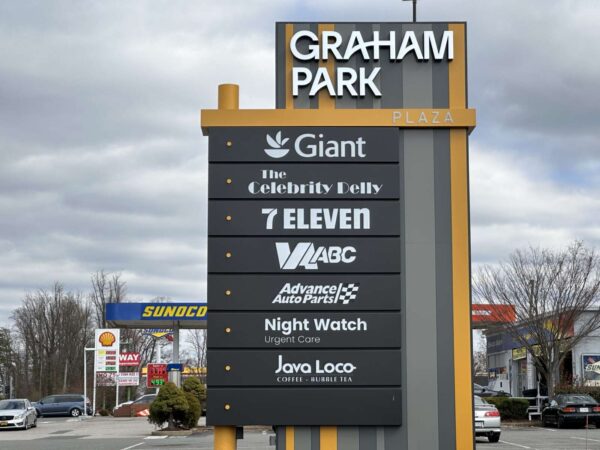
Fairfax County is looking into adjusting its signage rules to allow for brighter and bigger electronic signs.
Casey Judge with the county’s Zoning Administration Division presented the proposed changes during a Board of Supervisors land use policy committee meeting on May 16.
The changes include increasing the maximum brightness for nonresidential districts to 300 nits (a unit that measures the brightness a sign is emitting) at sunset. Current regulations require electronic signs to automatically dim to 40-100 nits at sunset.
The changes also includes requiring sign permit applicants to submit sign specifications.
In addition, the three existing application processes that the county currently has for nonresidential areas could be consolidated into one process.
“This does mean that all sign applications would go to the board for approval rather than the current [comprehensive sign plans],” which only need to be approved by the Fairfax County Planning Commission, Judge said.
Proposed modifications for electronic display signs with special exceptions include increasing the number, height, and size of freestanding signs, allowing building-mounted electronic display signs, and increasing the brightness to 600 nits.
Last May, while discussing the matter, county staff told the committee that the existing rules are old and that businesses wanted to be more competitive. Judge also suggested that easing the application process could be helpful to businesses.
Hunter Mill District Supervisor Walter Alcorn, the committee’s vice chair, questioned how the county is handling the convergence of “what’s a sign and what’s a display.”
“These things that we have traditionally dealt with as signs are being used in other means, or for other purposes,” Alcorn said.
Judge said a standard has been added that focuses on traffic safety and overall placemaking effects as part of the electronic display signs.
“I do hope that that standard can help guide our staff when they’re making that analysis to ensure that we’re looking at size and location, more so than the content in making our recommendations,” Judge said.
Braddock District Supervisor James Walkinshaw questioned the proposed increase from 100 to 300 nits, which he called pretty significant.
“That’s really in response to research looking at other jurisdictions that have much higher nit level limitations and it allows for those higher definition screens that we’re seeing,” Judge answered.
Judge said the county is seeking authorization and public hearings later this year.
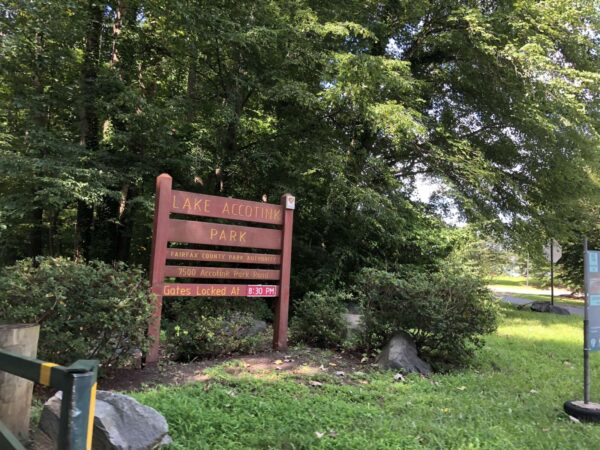
Lake Accotink Park’s playground has seen better days, not unlike the lake itself.
The Fairfax County Park Authority closed the playground at the popular Springfield park in November after an inspector determined the rusting equipment was “unsafe for use,” Braddock District Supervisor James Walkinshaw said at a Board of Supervisors meeting yesterday (Tuesday).
The supervisor proposed allocating $300,000 to replace the playground. An attempt to repair the equipment faltered because the vendor that originally provided the playground in the mid-1990s is no longer operating, according to Walkinshaw.
“Other playground vendors do not offer matching replacement components that would allow for a safe repair and re-opening,” Walkinshaw said. “In the months since the playground’s closing, FCPA has exhausted every avenue possible to procure the needed matching replacement part. At this point, the only option left for the opening of a safe playground at Lake Accotink Park, is a full replacement.”
The funding request will be considered as part of the board’s budget review for the third quarter of fiscal year 2023, which ends June 30. Other items being discussed for the $51.2 million available to the county include upgrades for the county’s tax payment system and running bamboo clearing projects.
Originally installed in 1995, the playground near the marina at Lake Accotink Park (7500 Accotink Park Road) features a swing set and a structure with five slides, ramps and inclines, a “shaky bridge” and a tic-tac-toe game.
The new playground will be different from the current one, according to Fairfax County Park Authority spokesperson Benjamin Boxer, though the agency is still determining the scope of the project.
“While there may be some common features, it will be an updated design and composition,” Boxer said. “Once a final project scope is determined, contingent upon approved funding, we will have a more concrete idea of the final playground concept. The updated playground will be in the same location as the existing playground area.”
The park authority won’t know exactly what materials are needed — and therefore, when construction can take place — until funding is approved, according to Boxer.
“If approved, we could proceed with completing the scope and ensure conformance with permitting,” he said by email. “An actual timeline will be available once the requisition is created and availability and potential delivery of materials is arranged.”
The playground project comes in the middle of a larger existential challenge to the 493-acre Lake Accotink Park, which celebrated its 60th anniversary in August and saw more than 300,000 visitors a year before the pandemic, according to Walkinshaw.
After years of planning to dredge accumulating sediment, county staff recommended earlier this year that the lake instead be allowed to fill up and transform into a wetland, stating that dredging would now be too costly and have too many negative community and environmental impacts.
The Board of Supervisors will discuss staff’s proposal at an environmental committee meeting on April 25.
“The replacement of the playground would not be affected by the outcome of the Board’s decision whether or not to dredge Lake Accotink,” Boxer said.
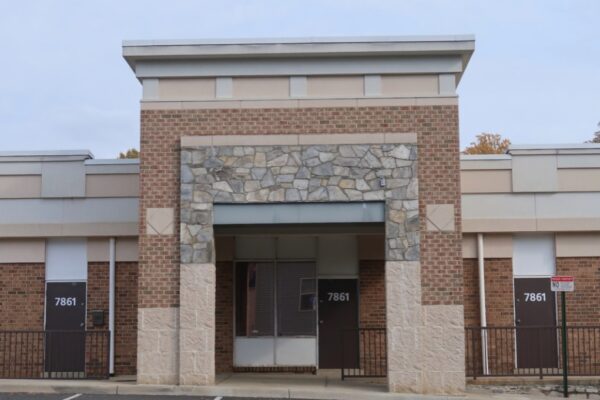
Fairfax County leaders will celebrate the grand opening of a community center in Annandale’s Heritage Mall tomorrow (Saturday).
Braddock District Supervisor James Walkinshaw and the county’s Department of Neighborhood and Community Services will open the Annandale Community Center with a ribbon cutting ceremony, an open-house, and community activities, according to a release.
The county is partnering with the Boys & Girls Club of Greater Washington to provide affordable after-school activities and youth programming in the 2,100-square-foot space. The center will add more programs and resources after the grand opening.
“The Annandale Community Center name was selected following multiple community engagement forums where the community gave input on the vision for the space, including resources, activities, programs, and names,” the release states.
Previously, the center was tentatively known as the Community Space at Heritage Center.
The facility occupies a former CrossFit space in the shopping center at 7879 Heritage Drive. It has been in the works since the Fairfax County Board of Supervisors approved a townhouse development behind the mall that included a commitment to providing a community resource center.
The grand opening will start at noon.
Join me + @FairfaxNCS this Saturday, March 4, to celebrate the opening of the new Annandale Community Center @ Heritage Shopping Plaza @ 12pm!
NCS is partnering w/@BGCGW to offer affordable youth programming + afterschool activities in the new space.https://t.co/p4O0aTHNGe pic.twitter.com/R8iXLfF3Kw
— Supervisor James Walkinshaw (@JRWalkinshaw) March 2, 2023
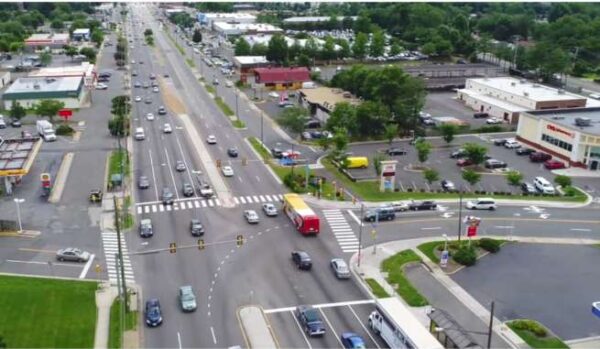
The clock is ticking for Fairfax County and the D.C. region to adopt a new transportation plan aimed at reducing greenhouse gas emissions.
This past June, the National Capital Region Transportation Planning Board (TPB) approved Visualize 2045 — a regional transportation plan that runs through 2045 and must be updated every four years, as mandated by the federal government.
At the same meeting, it voted to include greenhouse gas emission goals in the next plan, targeting cuts of 50% by 2030 and 80% by 2050.
Now, six months later, Fairfax County is already preparing to submit its segment of that plan with those emission goals in mind, but the process will be slightly different from previous years.
Presented at the Board of Supervisors transportation committee meeting on Tuesday (Jan. 31), Visualize 2050 will include “zero-based budgeting,” meaning all localities have to resubmit their transportation projects for consideration to ensure they adhere to the new emission reduction goals.
Before, most projects automatically carried over from one plan to the next, though projects could be added or taken out if needed, Fairfax County Department of Transportation planner Malcolm Watson explained to the supervisors.
Hunter Mill District Supervisor Walter Alcorn, who’s on the TPB with Braddock District Supervisor James Walkinshaw, noted that the board has had a “lively discussion” over the last few years regarding the emission goals.
“There’s been…quite a difference of opinion on the climate change stuff, particularly between the inner jurisdictions and the outer jurisdictions,” Alcorn said. “We are kind of right in between.”
County staff have identified 33 projects they expect to be part of the transportation plan and will need to be resubmitted under the new standards. Projects currently “in development” include Reston Parkway improvements, a new Dulles Airport Access road from Chain Bridge Road, and a widening of Frying Pan Road from Sully to Centreville roads.
Most of those projects are expected to be completed between 2025 and 2040.
There are 25 projects that could be exempted from the emission standards because they are already funded or under construction. Those include the Richmond Highway Bus Rapid Transit system, an I-495 overpass at Tysons Corner Center, and the $237 million Soapstone Connector.
Watson cautioned that the lists may change as projects get taken off and added, depending on priorities, the new emission goals, and other factors.
Next month, the TPB will issue a “call for projects,” and the lists will be officially published for public review.
“This will officially kick off Visualize 2050,” Watson said.
The county board ultimately will have to vote to approve the project lists over the summer before they get submitted to the TPB.
The hope is that by December 2024, the TPB will approve Visualize 2050, and the new emission goals will become the norm, making Visualize 2055 perhaps a bit less labor-intensive.
Photo via Fairfax County
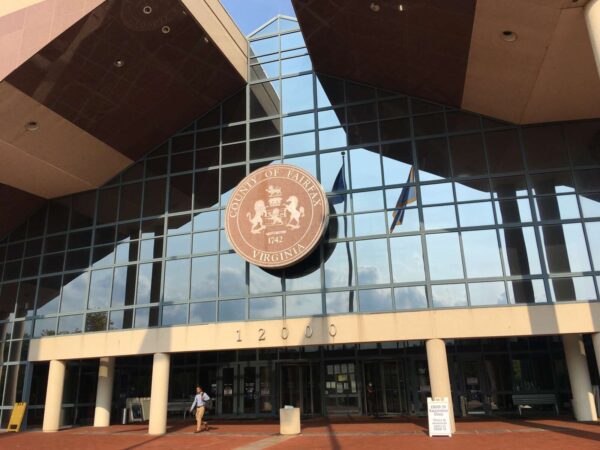
(Updated at 1:15 p.m. on 11/30/2022) Local officials are already preparing for “one of the most challenging” budget talks in years due to inflation, the changing real estate market, and staff retention challenges.
Right before the Thanksgiving holiday, Fairfax County staff offered supervisors and the school board an early look at projected revenues, expenditures, and points of potential discussion as the county and Fairfax County Public Schools (FCPS) prepare to release proposed budgets early next year.
The fiscal year 2024 budget forecast that staff presented on Nov. 22 didn’t paint a particularly rosy picture, however.
Board of Supervisors Chairman Jeff McKay called the forecast “a real mixed bag.” County staff said that generated revenue remained “healthy,” but others weren’t so sunny.
“This is probably going to be one of the most challenging budgets in my 11 years on the [school] board,” Braddock District School Board representative Megan McLaughlin said. “It’s going to be a tough one.”
Springfield District Supervisor Pat Herrity concurred, saying there wasn’t “a lot of good news in here.”
As is the case across the country, the local real estate market has been slowing due to increasing interest rates and rising prices. While it increased from last year, growth is expected to flatten going forward for the rest of 2022 and into 2023.
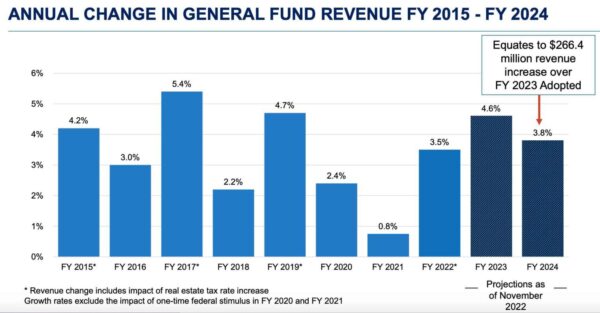
Non-residential tax revenue is in even worse shape, at least partially due to the change in work-from-home habits resulting from the pandemic. It’s expected to increase by only 0.6% compared to last year when the growth was about 2.3% compared to 2022.
While hotel, retail, and apartment revenues are all expected to increase next year, office revenue is expected to decline between 5% and 6%, raising concerns among some supervisors and school board members.
Braddock District Supervisor James Walkinshaw said he has talked to companies in the county that have no intention of renewing office leases due to decreased need with more employees now teleworking.
He called it a “slow-moving crisis” that could create a “very significant hole” in terms of missing revenue.
“[This] is very troubling,” Walkinshaw said. “It’s a structural challenge now in our economy…I’m not confident we have our arms around what that challenge is going to look like over the next 5 to 10 years.”
New construction and transient occupancy (or lodging) tax revenue are also expected to grow, but at much lower rates than prior to the pandemic.
Real estate taxes are the largest source of revenue for the county, providing more than two-thirds of generated money. Last year, home values soared, while commercial tax revenue dropped, resulting in a 3-cent decrease in the real estate tax rate.
All told, revenue is predicted to rise by about $266 million, a 3.8% increase from last year, per the presented forecast.
However, revenue isn’t keeping pace with expenditures, due mostly to anticipated staff salary increases.
Between recruitment and retention challenges and inflation, an additional $159 million will be needed for salaries and benefits compared to the current budget — plus another $113.5 million for school staff. Adding in other costs, the county and FCPS are looking at a combined shortfall of about $125 million for fiscal year 2024, which begins July 1, 2023, staff said.
Since this is a baseline forecast, a number of county and school priorities were not taken into account, including infrastructure upgrades, increased investments in affordable housing, and an expansion of early childhood education programs.
As county staff and McKay both reiterated, the forecast is only an estimation subject to change.
“As the economic outlook is uncertain, staff is approaching FY 2024 revenue forecasting very conservatively,” the presentation said.
Adoption of the fiscal year 2024 budget remains six months away. Advertised budget plans for the county and schools will be released in February with final votes coming in May 2023.

(Updated at 11:25 a.m. on 8/5/2022) Fairfax County is exploring being the first Virginia locality to create a “green bank” as a way to achieve carbon neutrality by 2050.
In a presentation to the Board of Supervisors’ environmental committee last week, county staff said a green bank can help spur investments in clean energy.
Essentially, a green bank is a publicly-funded financial institution that helps fund, develop, and support clean energy technologies for both residential and commercial entities.
“A green bank can act as a program sponsor, a trusted advisor, and a clearing house of information for residents and the private sector,” John Morrill, from the county’s office of environmental and energy coordination, said in his presentation to the committee.
The board asked staff to look into the idea of a green bank two years ago, ultimately authorizing $300,000 for a feasibility study. The General Assembly also passed legislation last year letting localities set up their own.
So far, the feasibility study found that a green bank could lead to $650 million of investments in just the first five years. Those investments would focus on residential energy efficiency measures, rooftop solar panels for both county homes and businesses, and shifting commercial car fleets to electric.
“The role of a green bank would be to encourage and facilitate those investments through targeted programs, direct incentives, and partnerships with private financial institutions and service providers,” Morrill said.
A few committee members questioned whether the county’s green bank would be “crowding out” private investment that would have happened regardless.
“That’s probably the crux of the issue and the most challenging operational,” Braddock District Supervisor James Walkinshaw said. “It doesn’t do us any good to fund a project that would have happened otherwise.”
According to staff, a county-backed green bank could help homeowners better afford improvements like solar panels or help make decisions about what’s right for them. For example, the county could provide “cash incentives” for installing rooftop solar panels in exchange for the county getting the renewable energy credits.
Morrill also noted that a green bank could help make improvements for low and moderate-income households that could benefit from the potential savings.
Staff recommended the county create a green bank as a non-profit 501(c)(3) with a board that could include county officials.
While no Virginia locality has a green bank yet, it is becoming a trend nationwide that was actually kicked off by nearby Montgomery County, which is among the first localities in the country to set up a county-backed green bank. D.C. also has a green bank.
(Correction: This article previously stated that Montgomery County was the first U.S. locality to create a green bank. While the county has said that, it was preceded in 2010 by New York City, which also claims to have the nation’s first local green bank, and St. Lucie County in Florida, which formed the nonprofit Solar and Energy Loan Fund.)
Staff recommended that the board follow Montgomery County’s lead in committing “a mid-range investment” for a green bank with initial funding ranging from $3 million to $15 million.
Chairman Jeff McKay suggested the county could partner with other local jurisdictions, so that Fairfax County doesn’t have to bear the sole financial brunt for an initiative that would benefit the region.
Committee members expressed overall support for the green bank proposal and asked staff to complete the study.
Staff will complete a draft ordinance and provide an official funding recommendation in the fall. The matter could come before the environmental committee for a vote in October with a Board of Supervisors public hearing scheduled for late this year or early 2023.
“If we initiate this, we have a chance to start this up in a way that not only benefits Fairfax County residents but also other counties around us to hopefully move more quickly adoption of ways to save energy and optimize our reduction in greenhouse gases,” Mount Vernon District Supervisor Dan Storck.
Photo via Sandra Parra/Unsplash

